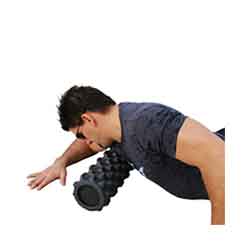 It is best if you practice the Lats Roll in conjunction with the Pecs Roll. Addressing both the lats and pecs in the same session maximizes the release possible in the largest muscles that limit your ability to raise your arm. If you have trouble with rotator cuff issues, shoulder impingement, frozen shoulder, or just about any other discomfort in your shoulders or neck, then this exercise is for you! The pectoralis minor muscle is involved in everything you do that involves the shoulder blade. When it locks up, all shoulder movements (and even some neck movements) are compromised. You should do this movement at least once every 2 weeks. (more often is better) The Pecs Presses in the extended regions may also be necessary to get the best release. Practice all the pecs techniques in rotation over 10-14 days along with all of the shoulder techniques (Primary, Secondary, and Extended) when you are attempting to clear a shoulder issue that needs more attention. |
|
For written instructions, click here to download a printable PDF of the Pecs Roll |
| Be sure to post your questions and comments below. We want to provide the best instruction to help you recover from your workouts. Click here to return to all of the Fundamental SMR Techniques **All information is provided for educational purposes only. You should consult your doctor before attempting any exercises you read on this page or any page on this website.** |
Tag: Shoulder Issues
Delts Press Wall & Floor
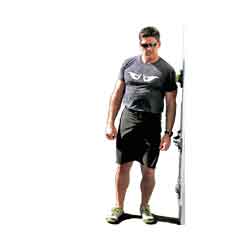 This SMR exercise addresses the three heads of the deltoid muscles. If you have trouble lifting your arms overhead then this exercise is for you! Keep in mind that the lats and pectoralis minor muscles are involved in everything you do with the shoulder blade. You will likely benefit from loosening knots in the delts, but be sure you stretch out the lats and the pec minor or your issue is likely to come right back. |
|
For written instructions, click here. (Video coming soon!) Click here to see the rest of the SMR Techniques. |
|
Be sure to post your questions and comments below. We want to provide the best instruction to help you recover from your workouts. **All information is provided for educational purposes only. You should consult your doctor before attempting any exercises you read on this page or any page on this website.** |
Sterno Press
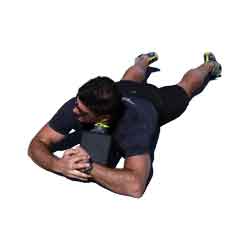 You will notice a number of issues that this muscle influences. The most important issue this muscle can cause is poor neck posture. If you can't easily lie flat on your back with your head and shoulders on the floor and your chin close to your chest, then this exercise is for you! The Neck Press and Scalene Press techniques are natural compliments to this SMR exercise, so do them together. |
|
For written instructions, click here. (Video coming soon!) Click here to see the rest of the SMR Techniques. |
|
Be sure to post your questions and comments below. We want to provide the best instruction to help you recover from your workouts. **All information is provided for educational purposes only. You should consult your doctor before attempting any exercises you read on this page or any page on this website.** |
Sterno Roll
 This SMR exercise is to address the layers of knots & adhesions in the numerous muscles in your neck. If you have tightness or discomfort in your neck, headaches, or general shoulder & neck issues, then this exercise is likely to help. |
| For written instructions, click here to download a printable PDF of the Sterno Roll |
| Be sure to post your questions and comments below. We want to provide the best instruction to help you recover from your workouts. Click here to return to all of the Fundamental SMR Techniques **All information is provided for educational purposes only. You should consult your doctor before attempting any exercises you read on this page or any page on this website.** |
Neck Roll
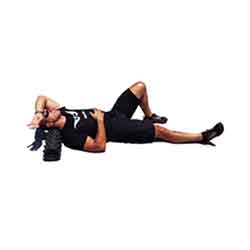 This SMR exercise is to address the layers of knots & adhesions in the numerous muscles in your neck. If you have tightness or discomfort in your neck, headaches, or general shoulder & neck issues, then this exercise is likely to help. |
| For written instructions, click here to download a printable PDF of the Neck Roll |
| Be sure to post your questions and comments below. We want to provide the best instruction to help you recover from your workouts. Click here to return to all of the Fundamental SMR Techniques **All information is provided for educational purposes only. You should consult your doctor before attempting any exercises you read on this page or any page on this website.** |
Delts Roll
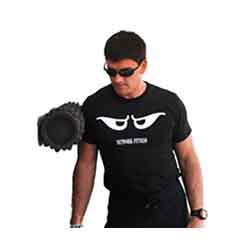 This SMR exercise is to address the layers of knots & adhesions in your delts. If you have tightness or discomfort in your shoulders, deep dull aches in your upper or mid back, or general shoulder & neck issues, then this exercise is likely to help. |
| For written instructions, click here to download a printable PDF of the Delts Roll |
| Be sure to post your questions and comments below. We want to provide the best instruction to help you recover from your workouts. Click here to return to all of the Fundamental SMR Techniques **All information is provided for educational purposes only. You should consult your doctor before attempting any exercises you read on this page or any page on this website.** |
Coracobrachialis

Pictured above is the coracobrachialis muscle. It is a small muscle that pulls your upper arm toward your head & towards your chest at the same time. Typically shoulder pain is caused by one or more of the other muscles that attach to or cross the shoulder joint. Take a good look at the pecs (especially the pec minor) and the rotator cuff muscles if you have shoulder discomfort.
The muscles are layered, showing how some of the muscles are covered by the others. All of the muscles are see-through so that you can appreciate the location and size of each muscle relative to the others.
Click here for a list of all the muscles.
Click here to see the shoulder muscles as a group.
Click your area of interest below. (any inactive links will be active soon)
Muscles that attach to the head or neck & the shoulder blade (scapula).
Muscles that cross the shoulder joint (attach somewhere in the torso and to the upper arm).
Muscles that attach to the shoulder blade (scapula) & the spine or ribs.
- Trapezius
- Levator Scapulae
- Rhomboid Minor
- Rhomboid Major
- Latissimus Dorsi
- Pectoralis Minor
- Serratus Anterior
Muscles that attach to the scapula & the arm
- Deltoids
- Supraspinatus
- Infraspinatus
- Teres Minor
- Subscapularis
- Teres Major
- Triceps (long head)
- Biceps Brachii
- Coracobrachialis
- Latissimus Dorsi
Good luck working out those tight knots.
If you have any questions, please post a comment. We try to respond within 24 hours.
We're here to help you get more out of your training!
The Shoulder

Pictured above are all the muscles that attach to the shoulder blade or cross the shoulder joint (there are a BUNCH of them). The muscles are layered, showing how some of the muscles are covered by the others. All of the muscles are see-through so that you can appreciate the location and size of each muscle relative to the others.
Click here for a list of all the muscles.
Click here to see the deltoid muscles as a group.
Click your area of interest below. (any inactive links will be active soon)
Muscles that attach to the head or neck & the shoulder blade (scapula).
Muscles that cross the shoulder joint (attach somewhere in the torso and to the upper arm).
Muscles that attach to the shoulder blade (scapula) & the spine or ribs.
- Trapezius
- Levator Scapulae
- Rhomboid Minor
- Rhomboid Major
- Latissimus Dorsi
- Pectoralis Minor
- Serratus Anterior
Muscles that attach to the scapula & the arm
- Deltoids
- Supraspinatus
- Infraspinatus
- Teres Minor
- Subscapularis
- Teres Major
- Triceps (long head)
- Biceps Brachii
- Coracobrachialis
- Latissimus Dorsi
Good luck working out those tight knots.
If you have any questions, please post a comment. We try to respond within 24 hours.
We're here to help you get more out of your training!
Deltoids

Pictured above are the deltoid muscles. There are three sections which pull your upper arm toward your head. The front portion (anterior deltoid) pulls up and forward, the middle portion (medial deltoid) pulls your arm straight up away from the side of the body, and the back portion (posterior deltoid) pulls the arm up and back. Typically shoulder pain is caused by one or more of the other muscles that attach to or cross the shoulder joint. If you have shoulder discomfort take a good look at the lats, the pecs (especially the pec minor) and the rotator cuff muscles in addition to the delts.
The muscles are layered, showing how some of the muscles are covered by the others. All of the muscles are see-through so that you can appreciate the location and size of each muscle relative to the others.
Click here for a list of all the muscles.
Click here to see the shoulder muscles as a group.
Click your area of interest below. (any inactive links will be active soon)
Muscles that attach to the head or neck & the shoulder blade (scapula).
Muscles that cross the shoulder joint (attach somewhere in the torso and to the upper arm).
Muscles that attach to the shoulder blade (scapula) & the spine or ribs.
- Trapezius
- Levator Scapulae
- Rhomboid Minor
- Rhomboid Major
- Latissimus Dorsi
- Pectoralis Minor
- Serratus Anterior
Muscles that attach to the scapula & the arm
- Deltoids
- Supraspinatus
- Infraspinatus
- Teres Minor
- Subscapularis
- Teres Major
- Triceps (long head)
- Biceps Brachii
- Coracobrachialis
- Latissimus Dorsi
Good luck working out those tight knots.
If you have any questions, please post a comment. We try to respond within 24 hours.
We're here to help you get more out of your training!
Biceps Brachii

Pictured above are the biceps muscles. Both of them pull your lower arm toward your shoulder. The biceps brachii rotates your lower arm as it flexes your elbow. The deeper of the two biceps muscles (the brachialis) is responsible for 'true flexion' of your elbow, and is involved in EVERY action you do that requires your elbow joint.
The muscles are layered, showing how some of the muscles are covered by the others. All of the muscles are see-through so that you can appreciate the location and size of each muscle relative to the others.
Click here for a list of all the muscles.
Click here to see the shoulder muscles as a group.
Click here to see the biceps muscles as a group.
The following muscles cross the elbow joint and attach to the shoulder blade (scapula) & the arm (radius or ulna), to the upper arm (humerus) & the arm (radius or ulna). Click the appropriate link for your interest.
Arm muscles that cross the elbow joint and flex the arm:
- Biceps Brachii
- Brachialis
- Brachioradialis - Front
Good luck working out those tight knots.
If you have any questions, please post a comment. We try to respond within 24 hours.
We're here to help you get more out of your training!
